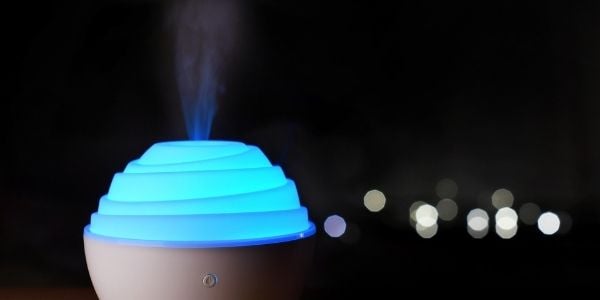 Memories are a very significant part of our lives. They can be triggered by sights, sounds, and smells. For me, smell is the most powerful memory trigger. Perhaps this is because scents are one of the only sensations that travel on a direct path to the memory and emotional centers of the brain. All other senses must go through a more tangled relay process.
Memories are a very significant part of our lives. They can be triggered by sights, sounds, and smells. For me, smell is the most powerful memory trigger. Perhaps this is because scents are one of the only sensations that travel on a direct path to the memory and emotional centers of the brain. All other senses must go through a more tangled relay process.
In the brain, the areas that process smells, memories, and emotions are very closely intertwined. Smells not only trigger memories but can lift our mood and generate a flood of feel-good emotions. Studies show that when we have a positive mindset, we are indeed healthier.
You are likely wondering why I am discussing smells and their ‘feel-good’ and health benefits for humans in an article about pets. On a quest to feel better and improve my health, I turned to the benefits of essential oils. Besides the many ways that I found they could improve my health, I found the many smells to be uplifting and cheerful. I wanted to share that with family and friends. But being a veterinarian, almost everyone I knew had pets. This made it important to find recipes that we all could use that would benefit our lifestyles and not harm our dogs and cats.
Skip to Essential Oil Recipes
I wanted to share some recipes with those who wish to diffuse their essential oils without fear of harming their cats or dogs. I personally use oils from Young Living Essential Oils. The recipes I've included below are based on their products, and I can only vouch for these specific oils. I've included Young Living Oils, recommended to be safe by a holistic veterinarian who extensively tested and used these oils themselves.
Another Preventive Vet team member uses Piping Rock. Neither myself nor Preventive Vet receives any commission from recommending either Young Living Essential Oils or Piping Rock. Wherever you purchase your oils, be sure to carefully examine the source, ingredients, and quality before using them in your home around your pets.
Before we dive in, I must point out some crucial precautions.
Diffusing Essential Oils Safely Around Dogs and Cats
Quality, Type, and Usage of Diffused Oils
- Only use 100% pure therapeutic grade essential oils and never fragrance oils.
- The term ‘Essence oil’ does NOT mean pure essential oil. Instead, it is a premixed blend of essential oil and a base carrier, such as vegetable or coconut oil. Do not use essence oils.
- Never diffuse poor-grade oils, especially around cats. High-grade oils list the Latin name of the plant species the oil is derived from as well as the part of the plant.
- All the recipes listed below are based on the use of 100% pure essential oil. While these recipes can be water-diffused in a well-ventilated room, never confine your pet to a small room while diffusing essential oils.
- Many sites will recommend avoiding citrus essential oils around cats. Used by a trained veterinary professional, they are used often and safely.1 As with any oil, but especially these oils (including peppermint), never let your cat lick it or apply directly to the skin.
- There is a lot of controversy about using peppermint, spearmint, and wintergreen with cats. If using 100% pure essential oils in the proper manner, there is significant data that they can be used safely. HOWEVER, if you have a cat and are uneasy about using essential oils in the mint family or if your cat is very sensitive to things, you can just omit the peppermint from any recipe's ingredient list.
- Since there are many other options, avoid using Melaleuca oil around cats.
- Cinnamon can be controversial with cats. One drop of water-diffused oil has been used safely. It should never be used directly as a single oil.
- Tea tree oil — if used correctly — can be safe and beneficial, but it is the most controversial oil in regards to cats. When you water diffuse essential oils, if they are pure and of good quality, it is safe in a ventilated and open room. Ingestion and topical applications of tea tree oil on cats are more likely to cause issues. Do not allow your cat to ingest tea tree oil, and do not apply it to their skin.
- For dogs, there can be issues, especially with unpure "hot" oils like cinnamon or ginger used on skin or orally. Diffusing cinnamon or ginger should be fine, though. Garlic oil is problematic, but that's not likely an oil you'll use in a diffuser.
Essential Oils and Your Pet's Respiratory System
- Pets' sense of smell is significantly greater than our own. Additionally, just like certain smells bother us, they can bother our pets. Also, pets can have an aversion to a certain oil due to an illness they may have. Essential oils are concentrated, and a single drop goes a long way.
- When using a recipe or following a diffuser guide, never apply more than the recommended number of drops. Also, when starting out, you can use fewer drops until you know how you and your pet will react to the smell. Be sure the room is large and open, and your pets can leave if they choose to.
Essential Oils and Direct Contact on Pets
- Do not apply essential oils to your pet’s skin or let them ingest it without speaking to a veterinarian trained in the use of essential oils with pets.
- If your pet comes into direct contact (via their skin or paw) with undiluted essential oil, do not use water or try to wash it off with water-based soaps or shampoo, as this can cause the oil to be driven further into the skin or spread more. Instead, apply a diluting oil or carrier oil (e.g., coconut oil, fatty vegetable oil) to the site. Then wipe it off. You may need to repeat this more than once. Once you are sure you have removed all of the essential oil and your pet is acting normally, you can bathe them.
Signs and Symptoms of Adverse Reactions to Essential Oils
The severity of reactions is associated with the pet’s weight, age, and species. Cats are more sensitive to essential oils compared to dogs due to the fact that they lack certain enzymes in their liver that prevent them from metabolizing them and ridding their bodies of certain toxins. Additionally, some essential oils contain phenols and phenolic compounds, which cats are highly sensitive to.
Many dogs and cats derive comfort from being close to their people. So, if a diffused essential oil is harmful to them, they may stay in the room and not leave. And animals don’t always know that leaving a room or space will remove the discomfort they’re feeling anyway. So, watching for signs of discomfort is the only way to detect if your use harms or makes your pet uncomfortable.
Watch for any of these symptoms that may indicate an adverse reaction to essential oils for your pet:
- Vomiting
- Diarrhea
- Wobbliness
- Drooling
- Lethargy
- Depression
- Weakness
- Tremors
Questions? If you're concerned about essential oil use around your pet, to chat with a veterinarian, click here
Essential Oils Recipes for Diffusing Safely Around Pets
Happiness Blends
Recipe 1:
4 drops Lemon
3 drops Lavender
3 drops Cypress
Recipe 2:
3 drops Valor
3 drops Orange
2 drops Cedarwood
1 drop Vanilla
1 drop Cinnamon Bark (or plain cinnamon)
Note: Cinnamon can be controversial with cats. One drop, water diffused has been used safely. It would never be used directly as a single oil.
Recipe 3:
3 drops Geranium
3 drops of Lemon
2 drops Orange
Recipe 4:
3 drops Geranium
3 drops Lavender
4 drops Lime
Recipe 5:
4 drops Joy
2 drops Grapefruit
Recipe 6:
4 drops Tangerine
3 drops Lavender
2 drops Lime
Rest and Relaxation
Recipe 1:
3 drops Peace & Calming
2 drops Frankincense
Recipe 2:
3 drops Gentle Baby
2 drops Stress Away
1 drop Lavender
Recipe 3:
4 drops Stress Away
5 drops Frankincense
3 drops Copaiba
Recipe 4:
5 drops Lavender
3 drops Cedarwood
3 drops Rosemary
2 drops Eucalyptus
Recipe 5:
3 drops Frankincense
3 drops Lavender
3 drops Cypress
Recipe 6:
4 drops Clary Sage
3 drops Bergamot
2 drops Lavender
Stress Release
2 drops Bergamot
2 drops Frankincense
Immunity Booster
2 drops Wild Orange (or regular Orange)
1 drop Rosemary
1 drop Eucalyptus
1 drop Cinnamon Bark
Inner Peace Blend
3 drops Stress Away
3 drops Cedarwood
Fresh Scents
Recipe 1:
4 drops Lemon
3 drops Lavender
2 drops Rosemary
Recipe 2:
3 drops Vetiver
3 drops Lemon
Recipe 3:
3 drops Lavender
3 drops Orange
Recipe 4:
5 drops Lavender
4 drops Tea Tree
3 drops Lemon
Tea tree oil — if used correctly — can be safe and beneficial, but it is the most controversial oil in regards to cats. When you water diffuse essential oils, if they are pure and of good quality, it is safe in a ventilated and open room. Ingestion and topical applications of tea tree oil on cats is more likely to cause issues. Do not allow your cat to ingest tea tree oil, and do not apply it to their skin.
Recipe 5:
4 drops Cedarwood
3 drops Lemon
2 drops Rosemary
Recipe 6:
4 drops Joy
3 drops Geranium
2 drops Cinnamon
Recipe 7:
3 drops Rosemary
3 drops Lemon
3 drops Joy
Recipe 8:
2 drops Lavender
2 drops Lemon
1 drop Rosemary
1 drop Grapefruit
Feel the Love Blends
Recipe 1:
5 drops Geranium
3 drops Lime
2 drops Oregano
Recipe 2:
4 drops Orange
3 drops Lavender
2 drops Patchouli
2 drops Ylang Ylang
Recipe 3:
3 drops Juniper
2 drops Clary Sage
1 drop Grapefruit
Recipe 4:
3 drops Black Pepper
3 drops Cinnamon
2 drops Citrus Fresh
1 drop Patchouli
Germ Blaster
4 drops Thieves
3 drops Tea Tree
3 drops Lemon
Tea tree oil — if used correctly — can be safe and beneficial, but it is the most controversial oil in regards to cats. When you water diffuse essential oils, if they are pure and of good quality, it is safe in a ventilated and open room. Ingestion and topical applications of tea tree oil on cats is more likely to cause issues. Do not allow your cat to ingest tea tree oil, and do not apply it to their skin.
Focus Blend
3 drops Black Pepper
3 drops Rosemary
Get Moving
2 drops Ginger
3 drops Lemon
3 drops Lime
Let’s Do This!
3 drops Clarity
2 drops En-R-Gee
Banish Brain Fog
Recipe 1:
1 drop Basil
2 drops Rosemary
2 drops Cypress
Stink Be Gone
5 drops Purification
4 drops Lemon
3 drops Bergamot
Spring Time Air Freshener
2 drops Lavender
2 drops Peppermint
2 drops Lemon
1 drop Copaiba
NOTE: There is a lot of controversy about using peppermint, spearmint, and wintergreen with cats. I have avoided putting any recipes with it until this one. If using 100% pure essential oils in the proper manner, there is significant data that they can be used safely. HOWEVER, if you have a cat and are uneasy about using peppermint or if your cat is very sensitive to things, you can just omit the peppermint from the ingredient list.
If you want to learn more about essential oils and pets, here are two helpful links:
I hope you enjoy these recipes as much as I do. Smell well, and best wishes!
















